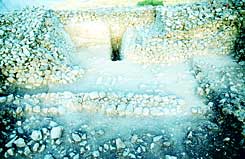About 5,000 years ago a rich culture flourished in the southern Golan. The question of what caused her disappearance still awaits a solution
Ran Shapira, Haaretz, Walla News!

The remains of the gate of the outer wall in Labia. Evidence of a violent end
Photo: Nikolai Trakhanov
Direct link to this page: https://www.hayadan.org.il/golanwall.html
At the end of a spur on the western slopes of the southern Golan Heights, above Moshav Ramot, a settlement existed for nearly a thousand years, which at its peak spread over about 90 dunams. In seven seasons of excavation at the site, known as the "Lion Complex", it became clear that the beginning of settlement in the place was approximately in 3300 BC, in the first phase of the Early Bronze Age.
The settlement prospered in the last centuries of the period - between 2700 and 2300 BC. In the excavations in the settlement, which took place mainly in the nineties and were managed by Lipaz Vinitsky as part of a regional project headed by Prof. Moshe Kochavi and the late Prof. Farahia Bek from Tel Aviv University, buildings built of basalt stone were discovered and in them were found pottery typical of the period and various industrial and storage facilities. There is also a cemetery on the southern slope of the branch with rounded burial structures.
The most impressive find in the settlement is the massive defense system that was built there. The system included two walls - an inner and an outer - designed to prevent invasion from the eastern side of the settlement. From the other three Hebrews the settlement was protected by a steep natural slope.
The dimensions of the stone foundations on which the walls were built, which were only uncovered in the excavations, testify to the strength of the defense system. The width of the plinth of the outer wall reached 16 meters and it was preserved at a height of more than four meters. The width of the inner wall was more modest, between five and ten meters. Near the southern end of the outer wall is a wide gate, on both sides of which towers were built for protection. There was also a similar gate in the inner wall.
The archaeologist Yitzhak Paz, who participated in the management of the excavations in Labia, says that the massive walls characterize other settlements built in the area at the same time. Paz, who is writing a doctoral thesis on the Early Bronze Age in the Golan in the Department of Archeology at Tel Aviv University, lists among them sites such as Katz Bardeville near Natur, Gamla (an ancient settlement on which the city that was destroyed in the revolt against the Romans was founded) and Niam, near the seat that bears the same name.
At the beginning of the archaeological research in the Golan, in the years after the Six Day War, the researchers believed that the area between the walls that were uncovered at these sites was empty of buildings. Therefore, it was assumed that no real settlements were established there, but it was used as pens for sheep and cattle of semi-nomadic populations. That's how the nickname "complexes" stuck to those sites.
The excavations in Labia proved that this interpretation was wrong and that already at the end of the fourth millennium BC, settlement began in the Golan Heights in sites that could provide the inhabitants with natural protection against enemies.
Paz points out that the massive fortifications, large buildings and pottery that characterize the Golan of the Early Bronze Age are similar to findings from other settlements from the same period that were uncovered in southern Syria, northern Jordan and the Land of Israel. However, unlike settlements from other regions, no temples or palaces of the period have yet been found in the Golan Heights. On the other hand, burial buildings of the period and the unique architectural complex of Rojum al-Hiri were uncovered, where a system of concentric stone circles surrounding a burial structure (rogam) was found. The diameter of the outer circle is 156 meters.
The massive fortifications, the megalithic burial structures and the unique Rujum al-Hiri complex are remnants of an impressive culture that flourished in the area about 5,000 years ago. But in the excavations in Labia it became clear that the strength of the fortifications did not prevent the occupation of the settlement. Near the gate of the outer wall at the site, many sling stones, a thick layer of fire and stone and brick avalanches were found, evidence of the siege in which the settlement stood. The gate itself was blocked with a stone wall, in an attempt to prevent its breaking. Fire marks discovered in the gate structure and near it show that the attempt did not go well and that the end of the lioness was probably violent.
It is not clear whether the other settlements of the period in the southern Golan also came to an end in a similar way. Today it is known that Gamla ceased to exist as a fortified settlement already towards the end of the first half of the third millennium BC. Towards the end of the Early Bronze Age, about 4,300 years ago, urban culture in the Golan ceased to exist on such an impressive scale. The question of what caused this still awaits an answer.
